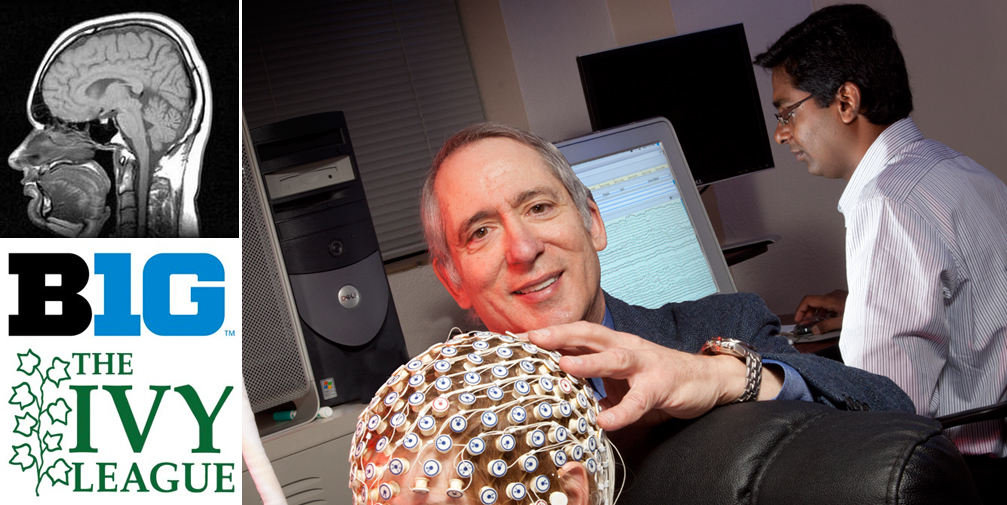
The Big Ten Conference and the Ivy League, in conjunction with the Committee on Institutional Cooperation, will engage in a cross-institutional research collaboration to study the effects of head injuries in sports, continuing efforts dating back more than two years. UNL’s Dennis Molfese is the Big Ten/CIC research collaboration director and will work on the initiative.
This historic collaboration brings together two prestigious academic and athletic entities, and allows for the coordination of ongoing efforts by each conference to research and address various aspects of head injuries in athletics, including concussions. The world-class academic and research capabilities of the institutions will help to promote a collaborative and collegial atmosphere to address a burgeoning issue impacting the welfare of athletes at all levels of sport.
“CIC member universities have collaborated for more than 50 years, but this is the deepest and most significant research and academic collaboration we've launched,” said Barbara McFadden Allen, CIC executive director. “It draws perfectly on the intersection of great medicine, great athletics and great academics that characterizes what is best in our universities. By working together across traditional boundaries, we can build the infrastructure to address the problem, assemble a much larger potential pool of athletes and draw upon the formidable research and medical fields and talents represented across the universities.”
In May 2010, the Big Ten became the first collegiate conference to establish a conference-wide concussion management plan. In 2011 the Ivy League developed and enacted a series of concussion-curbing measures in the sport of football after a year-long review. Since September 2011, the two conferences have engaged in discussions to examine the feasibility and benefits of collaboration, while outlining the framework and objectives associated with the initiative.
Through academic research and shared resources, the collaboration will promote positive and constructive change for injury assessment and improved long-term outcomes. In addition to establishing a core leadership group to help lead the initiative, each conference will identify researchers and related participants from each school, as well as a few selected external subject-matter experts. The effort will develop a research network of sports medicine personnel, neurologists, neuropsychologists, neurosurgeons, biologists, epidemiologists and other experts to set up and implement research protocols across the group.
“The opportunity for collaborating on such a landmark series of studies with the Ivy League is unprecedented in sports medicine,” said Molfese, who is also director of UNL's Center for Brain, Biology and Behavior. “Frankly, this is a unique moment in the history of science. There is no question that this research program will be greatly strengthened by bringing together in a genuine partnership the outstanding and cutting-edge scientists, athletic trainers and team physicians of both conferences to better understand and reduce as well as treat head injuries.”
Formal collaboration between the Big Ten and the Ivy League will extend and enhance the work already undertaken by both conferences over the past two years in their efforts to address issues related to head injuries in intercollegiate athletics, including:
• Developed a “Concussion Management Plan” for use by conference institutions, including baselines for return to academic and athletic activities (Big Ten, 2010)
• Conducted presidential discussions concerning the existing data and research regarding concussions in athletics and identified steps to enhance student-athlete safety (Ivy League, 2010)
• Developed a “Concussion Return to Play Checklist” and obtained agreement from athletic medicine staffs to use the checklist as a guide for their respective schools (Ivy League, 2011)
• Convened an ad hoc committee to review concussions in football and developed a series of recommendations, implemented in fall 2011, with the goal of lowering the incidence of concussion and subconcussive hits in football (Ivy League, 2011)
• Conducted a Head Injury Summit, with more than 40 attendees across several disciplines, including athletic medicine, neurology, neuropsychology, physics, engineering and biological sciences (Big Ten/CIC, 2011)
• Created a centralized data-sharing platform to enhance existing surveillance and research and accelerate new inquiries into concussions (Big Ten/CIC, 2011)
• Convened additional ad hoc committees to review concussions in men’s and women’s ice hockey, soccer and lacrosse and will make recommendations for those sports (Ivy League, 2012)
• Launched a research initiative on how head injuries affect athletes in all sports (Big Ten/CIC, 2012)
For more information, go to the CIC's Traumatic Brain Injury Collaborative website, http://www.cic.net/Home/Faculty/BrainInjury.aspx.